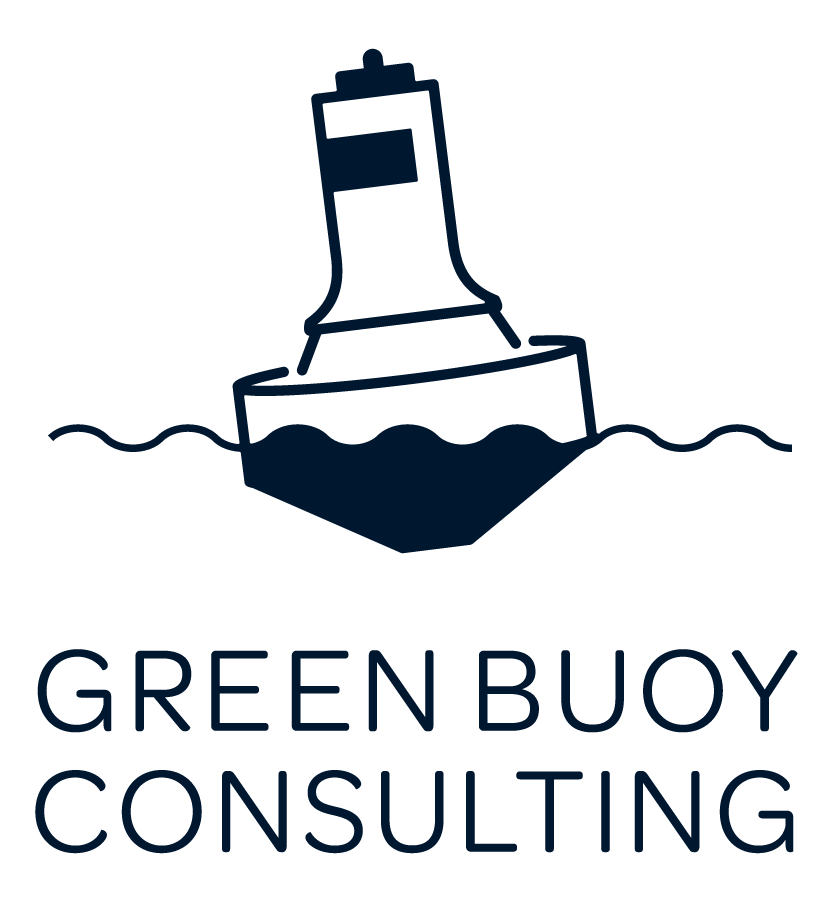What a Fractional Sustainability Expert Does
(From My Desk at Green Buoy Consulting)
Many growing private companies are getting requests from stakeholders about ESG, but hiring a full-time person focused on sustainability isn’t always practical or necessary. That’s where a Fractional Sustainability Expert comes in. A fractional sustainability expert provides strategic guidance and hands-on execution to help companies integrate sustainability into their daily operations and meet stakeholder demands.
When Companies Hire a Fractional Sustainability Expert
Clients usually reach out to me when sustainability moves from “nice-to-have” to business-critical. Business-critical usually means money. Common scenarios when I get a call include.
Investor requests: Private equity or other investors ask for carbon footprint data, climate risk analysis, or science-based targets. These requests are not just tickboxes and require dedicated support to execute.
Customer pressure: Multinational RFPs require sustainability data or ESG practices. As large companies act on their climate commitments, they look to their supply chain to set targets and collect environmental data.
Internal initiatives: Teams want to act but lack experience, structure, or bandwidth. An extra set of hands can be enormously helpful in managing projects like materiality assessments or EcoVadis questionnaires.
Growth or transition: Scaling operations, preparing for acquisition, or entering new markets triggers ESG expectations. Working with someone over 12-18 months to prepare for an IPO can pay off once a company is public and subject to more rigorous reporting requirements.
Once a company has identified a critical space for improvement, the work begins.
What I Do as a Fractional Sustainability Expert
Every engagement is tailored, but most involve a combination of assessment, strategy, and execution:
1. Baseline Assessment & Materiality
We start by understanding where the company stands and what external requests they’re subject to. For most companies, this is the first time they’ve considered sustainability or ESG, so their internal documentation and information are limited. These baseline assessments could include one of the following, or a combination of each of the below.
Conducting a greenhouse gas (GHG) inventory (Scopes 1, 2, and 3)
Reviewing sustainability initiatives, policies, and processes
Evaluating investor or customer requirements to understand what’s being asked
Considering a baseline assessment in light of current requests and the landscape ensures the strategy is grounded in the company’s current reality.
2. Strategic Roadmap & Prioritization
Once the baseline is clear, we build a practical roadmap aligned with business priorities:
Setting emissions reduction targets and integrating them into a climate strategy.
Identifying short-term actions and long-term initiatives, and which to prioritize.
Aligning plans with external standards like SASB, GRI, or B Corp.
Who should be responsible for each of these initiatives and requests.
The focus is on actionable strategy, not just aspirational documents. In 2025, many companies want to meet requests and develop a plan that meets external requirements but doesn’t go above and beyond.
An external expert helps clarify where to spend valuable time, how to prioritize and what internal resources are required over the long term.
3. Tactical Delivery & Integration
Unlike a traditional consultant, I work alongside the team to implement initiatives like:
Collecting and verifying sustainability data across departments
Building dashboards or reporting templates
Updating supplier questionnaires, policies and internal guidance
Training teams or facilitating workshops to integrate ESG into daily decision-making
Clients hire me because I can combine expertise with execution, ensuring plans are implemented and meet investor or customer expectations. Especially for mid-size, private, growth-oriented companies, money is better spent on someone who can integrate rather than just develop a strategy or a slide deck.
4. Reporting & Communication
I help companies accurately communicate their progress to those asking about sustainability. Working with companies to develop a cadence, we set up reporting and messaging like:
Investor updates or ESG summaries
RFP responses for multinational clients
Internal dashboards and progress reports
The outcome is credible, measurable progress that supports business growth.
Tangible Outcomes of Fractional Sustainability
Many companies are curious what a tangible outcome of fractional sustainability looks like.
Private Equity–Backed Financial Services Firm: Over six months, create a three-year ESG roadmap, complete a baseline carbon footprint, and develop accompanying reporting templates for PE investors.
Consumer Goods Company: At the request of a multinational retailer, we conducted a Scope 1–3 footprint, identified emissions hotspots in packaging and logistics, and implemented supplier engagement processes.
Private Equity–Backed Pharma Services Firm: Over six months, created a 12-month climate strategy, completed a baseline carbon footprint, and developed accompanying emissions reduction targets.
Why the Fractional Sustainability Model Works
A fractional sustainability officer offers dual capability:
Strategy & Roadmapping: Prioritize initiatives and align with standards
Tactical Delivery: Implement processes, collect data, train teams, and produce reports
Clients gain clarity, accountability, and credibility, and their sustainability initiatives progress. They can confidently respond to investors and customers while building long-term internal capacity.
Get Sustainability Done — Without Hiring Full-Time
At Green Buoy Consulting, I help companies turn sustainability strategy into action. From carbon accounting to RFP response, supplier engagement, and ESG roadmap development, the fractional model allows growing organizations to do it efficiently and effectively.
Don’t miss our other blogs










